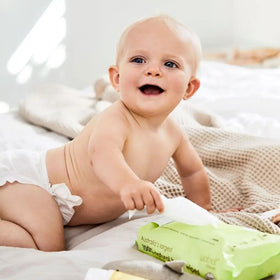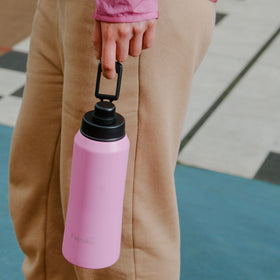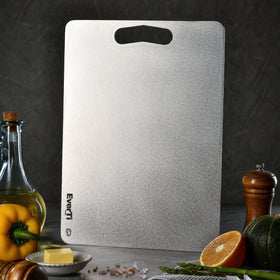
Are Your Baby Wipes Giving Your Baby Nappy Rash?
Updated 25 April 2023
The other day, I was talking to someone who was telling me that her baby had been hospitalised because he had such bad nappy rash. She said that until she read our Safer Baby Wipes Cheat Sheet, that she had no idea that wipes could be part of the problem.
Changing both the nappy and the wipe that she was using on her baby had made a world of difference. Most of us use baby wipes at every single nappy change. Which means that we're using a lot of wipes on our baby. So it's really important that you know what's in those wipes before you put them on your baby.
The ingredients in your baby wipes could be causing nappy rash
Huggies says that a "safe and gentle baby wipe is essential for your baby’s skin health" and that Huggies wipes are "safe to use on baby's face and hands". And yet two of ingredients that Huggies are saying are ideal for "cleaner, healthier skin" are irritants. Among the ingredients listed are:- phenoxyethanol
- malic acid
The European Union (EU) says that phenoxyethanol is "toxic or harmful for products used around the mouth". France wants a ban on it altogether on products used in the 'diaper area'. There's evidence to show that malic acid is an irritant when it's used in products on the skin or around the eyes. So you really shouldn't be using Huggies baby wipes around baby's face, and they could be causing your baby irritation around their bottom, too. That's just the first brand that I looked at. [Note: Huggies removed phenoxyethanol from their baby wipes formula in 2017 in response to consumer concerns.]
I checked Curash baby wipes, and found one called Curash Simply Water Baby Wipes. Apparently, these contain 99.8% water. Sounds good, right? Um, no. Because when you look at the ingredients, you'll also find Methylisothiazolinone (MI). You don't have to search far to find that MI was widely reported a couple of years ago as causing terrible irritations on parents' hands when they used baby wipes containing this ingredients. [Note that as at 25 April 2023, the ingredients have been changed to include polysorbate 20 and phenoxyethanol - not as problematic, but still not great; the new formula no longer includes MI, too.]
What ingredients should you avoid in baby wipes?
There's a few ingredients that you really need to avoid:
Methylisothiazolinone (MI)
A couple of years back, it was widely reported that the preservative Methylisothiazolinone (MI), commonly found in baby wipes, was causing an increase in contact dermatitis. Research published in the Medical Journal of Australia in March last year showed rates of allergic reactions to MI had risen from less than 4 per cent to 11 per cent in two years. MI was even awarded the 'Allergen of the Year' award in 2013 by the American Contact Dermatitis Society. (Gosh, can't you just imagine how much fun their Christmas parties would be?) Lots of brands have removed this ingredient from their baby wipes, but not all.
Iodopropynyl butylcarbamate (IPBC)
A few years ago, baby wipes were recalled in New Zealand because they contained iodopropynyl butylcarbamate (IPBC). The New Zealand Health Ministry said the wipes were recalled because:
"IPBC may pose a public health risk because of their potential sensitising and allergenic effects.
In 2001, Danish researchers found that the use of IPBC in cosmetic products 'can lead to contact sensitisation and allergic contact dermatitis'. Results of patch-test studies ... in 2003 also showed that IPBC is considered to be a proven contact allergen."
Parabens
Parabens are preservatives that are often used in skincare products, and in some people they can cause irritations and even allergic reactions. The main problem with parabens, though, is that they are endocrine disrupters. Endocrine disrupters are chemicals that can interfere with the body’s endocrine (or hormone) system. Endocrine disruption has been linked to obesity and diabetes, female reproduction, male reproduction, hormone-sensitive cancers in females, prostate cancer, thyroid, and neurodevelopment (brain development).
SLS and SLES
Sodium Lauryl Sulfate (SLS) has long been known to be an irritant, and so is Sodium Lauryl Ether Sulfafe (SLES). They're known as sulfates (or sulphates) and there are many varieties of them, but these are very common ones.
PEGs
PEGs are polyethylene glycols, and they're another common ingredients in skincare products. PEGs are a problem because they may be contaminated with cancer-causing chemicals. They can also cause irritation if they're used on broken skin. So they're not safe if your baby has nappy rash.
Propylene Glycol
Propylene glycol is another skin irritant, and should be avoided in baby wipes. But you'll find this in Nature Baby, Coles and the Aldi baby wipes.
Perfumes & Fragrances
Another winner of the 'Allergen of the Year' Award from the American Contact Dermatitis Society. The Dermatologist says that fragrances are responsible for 30 to 45% of ACD (allergic contact dermatitis) to cosmetics. Not everyone is going to be sensitive to fragrances, but if you are, it's hard to work out exactly what it is in the fragrance that is irritating to you. That's because fragrance ingredients are considered to be 'commercially sensitive' so manufacturers don't have to disclose them. You'll find fragrance in many of the supermarket baby wipes. One of the problematic ingredients in fragrances can be phthalates.
Phthalates
You won't find the word 'phthalates' in the ingredients list for baby wipes. But that doesn't mean they're not in there, as they may be in the fragrance. Phthalates are suspected of being an endocrine disrupter, and have been linked to problems with sexual development. Lower sperm counts and problems with reproductive health like undescended testes or deformed penises.
DMDM hydantoin
DMDM hydantoin is used as a preservative, and it's a known allergen, and an irritant when it's used around the eyes or on the skin.
2-bromo-2-nitropropane-1,3-diol
This is another preservative that's an allergen and an irritant. It's an irritant when it's used around the eyes, or on the skin, or if it's inhaled. So it's another ingredient that you really don't want to be using on your baby's bottom, hands or face.
It's not hard to find these ingredients in baby wipes. And I'm also not saying that all these wipes are terrible. But if you're wondering why your baby has nappy rash, perhaps you need to be taking a look at what's in those wipes you're using at every nappy change. If you think you're never going to be able to remember these chemical names, why not jump on to our safer baby wipes cheat sheet and find out exactly which baby wipes are safest to use on your baby?
Don't forget, all the baby wipes at Hello Charlie have been researched and hand picked by me, so you know that they're safe for your baby.











